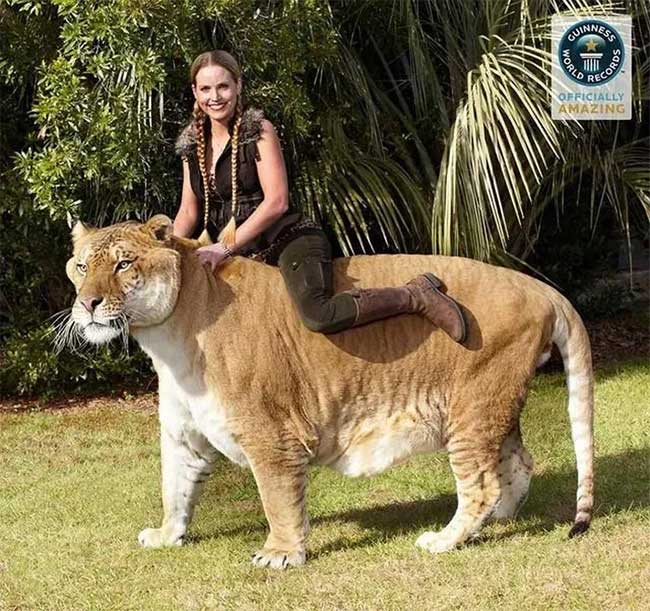This liger, weighing 705 lbs (320 kg), is named Apollo, one of the largest ligers in the world, and it is nearly the size of a prehistoric saber-toothed tiger.
Apollo is a hybrid of a male lion and a female tiger – hence the name liger. Ligers differ from tigons, which are born from a female lion and a male tiger, as they tend to grow much larger than their parents. They are so large that they can be compared to prehistoric saber-toothed tigers.
Both ligers and tigons have health issues due to human intervention. They often have to be born premature and typically do not live beyond 12 weeks. Some that live longer do not exceed 10 years of age (the average lifespan in the wild for tigers is 10-15 years, for lions 10-12 years, and over 20 years in captivity) and often face various problems such as neurological defects, arthritis, rickets, weak immune systems, depression, and infertility…
The history of breeding between lions and tigers dates back to the early 19th century in India. In fact, the two species live separately in the wild, so their hybrids can only be found in captivity. Currently, there are fewer than 1,000 ligers in the world.

According to veterinary experts, ligers are hybrids of male lions and female tigers. This hybridization method is considered very unique and rare. The liger is known as the largest member of the big cat family in the world, exhibiting traits similar to both lions and tigers. Upon reaching adulthood, ligers are larger than both of their parents. However, they can only thrive in artificial environments because the habitats of lions and tigers differ in the wild.
Even among the hybrids of these two species, Apollo is regarded as a rare individual. He and his three siblings are the first white ligers in the world, born from a white male lion and a white female tiger in December 2013.
At that time, Apollo was the smallest of the four siblings, and according to his owner, he behaved more like a kitten than a tiger or lion, purring and always wanting to be petted.

The history of breeding between lions and tigers dates back at least to the early 19th century in India. In 1798, Étienne Geoffroy Saint-Hilaire (1772–1844) wrote descriptions of the offspring of lions and tigers. The term “liger,” a portmanteau of lion and tiger, was coined in the 1930s. Ligers have striped patterns similar to tigers but with less vibrant colors, displayed on a light brown-gray background. These stripes can be black, dark brown, or tan. The corresponding background colors can be gray, tan, or yellow. Due to hormonal issues, ligers struggle to reach full maturity. They take longer to achieve their full adult size. Continued growth in shoulder height and body length has not been documented in ligers over 6 years old.

Ligers are the largest living members of the cat family on our planet. Genetic improvements may be a factor contributing to the enormous size of this species. These genes may or may not express in the parents but play a crucial role in the hybrid’s development. For instance, in some dog breeds, these genes help them grow faster than their parent breeds. Such growth does not manifest in the parent breeds because these genes are often “turned off” due to genes inherited from that breed’s female. Some hybrids within the cat family can also reach sizes similar to ligers: the ligon, a rare hybrid between a male lion and a female liger, is exemplified by a female named Cubanacan at the Alipore Zoo in India, which weighed 363 kg. Due to the rarity of these second-generation hybrids, it is difficult to determine whether the average size of ligons is larger or smaller than ligers.
|
Saber-toothed tigers were among the fiercest predators on Earth during the Ice Age, existing from 3 million to 10,000 years ago in the Americas. With canines up to 25 cm long and sharp claws, saber-toothed tigers were a source of fear for many species living during that time. Saber-toothed tigers began to mark the onset of extinction around 10,000 BC. Currently, there are many hypotheses proposed by scientists regarding the causes of the saber-toothed tiger’s extinction. Some scientists believe that the rise of prehistoric humans was the main cause. Additionally, the end of the Ice Age reduced habitats, altering vegetation and pushing saber-toothed tigers to the brink of extinction. |





















































